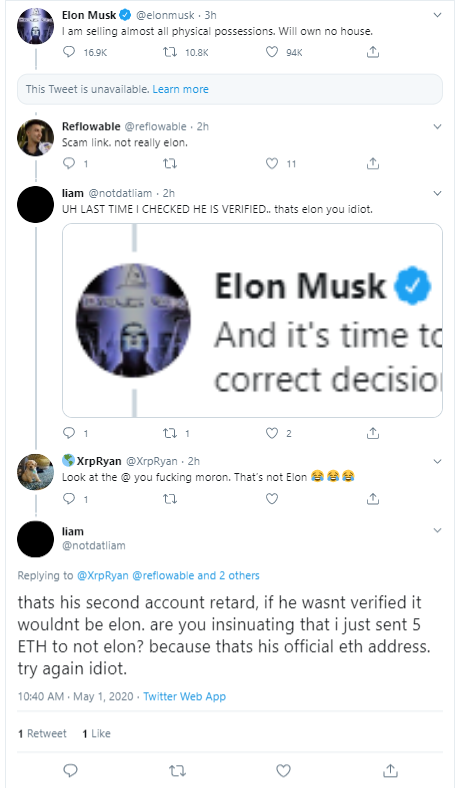I want you to visit www.elongivesbtc.com for a moment. Don’t believe what you see. Notice that it’s designed to perfectly imitate a Medium article, down to the little icon that appears in its browser tab. But that’s not an article on Medium.com. Elon Musk doesn’t have an account on Medium, that I can find.
It’s nothing but an even simpler version of the advance fee scam, as seen in the Roommate Scam or the classic 419 Email Scam. It’s also often a component of the IRS phone scam, or Publisher’s Clearing House scam. Each with different window dressing but sharing the same mechanism of how they get you to send them money, and (temporarily) believe that you’ve gotten money from them (until the check bounces).
What differs here is that there’s no mechanism for creating even the temporary illusion that you got paid. Instead it compensates with even more elaborate window dressing, invoking tech billionaires who plausibly might give out crypto as the industrial tycoons of old used to shower peasants with paper money from their balconies, and a pixel perfect recreation of a trusted site (in this case, Medium).
It won’t fool anybody who thinks to perform even a cursory search of Medium for Elon Musk, but it looks believable enough to bamboozle some suckers. Here’s one of them now:

Then, not much later…

What I want you to take special note of is the attitude on display in the first of these two images. Reflowable and XrpRyan were trying to help liam not be taken advantage of. But, human nature being what it is, someone irreversibly invested into a mistake will attack the bearer of bad news, as though killing the messenger will make their warnings untrue.
You see this exact same attitude in MLM distributors when they encounter skeptics, sharing with them publicly available financial disclosures from the companies like DoTerra, LuLaRoe, Arbonne, etc. that they distribute for:

Different scam, same predictable human reaction. From the mark’s perspective there are two possible realities. Scenario A, in which they’re a shrewd financial genius destined for success. Scenario B, in which they’re a gullible fool who was taken for a ride, putting money into a scam they’ll never get back, rudely rebuffing all the patient friends who tried to intervene.
Obviously these two scenarios aren’t equally probable. Only one of them was real, from the start. We don’t live in some sort of quantum loony tunes bit where the tunnel painted on the wall may or may not be possible for Wile E. Coyote to enter.
However, Scenario A is much, much more appealing than Scenario B. So much so that the mark will cling to it, against any and all indications that in fact, Scenario B is reality. They have powerful motivation to somehow find a way for Scenario A to be real.
If you intend to keep a number of people fooled for your own individual or group gain, cultivating this mindset in your marks saves you a lot of work; Now you don’t need to follow him around, explaining away contrary evidence he encounters, nor driving off skeptics that might talk him out of it: He’ll do all that stuff on his own. Not realizing all the while that doing so serves your interests, not his.
Hence a great deal of time, effort and money goes into the creation of apologetics. MLMs like Amway, Herbalife, etc. typically sell “motivational” CDs and books to distributors attending their seminars, much of it uplifting self help pablum but also advice on how to argue with friends and family trying to clue members into the fact that they’re being fleeced.
They already badly want to not be fooled, all you need to do is provide them with plausible sounding arguments to further convince them that they’re not fooled, with which they can also frustrate the efforts of friends and family to help them.
Often they eventually realize anyway, but well crafted apologetics greatly delay that realization. For some, indefinitely. They’ll go to their grave still baffled that shilling protein shakes on Facebook didn’t make them rich, still shaking their fist at the naysayers who they might blame in part for their failures.
Here’s another instructive example of the phenomenon we’ve been examining. In 2016, a Fort Wayne Community Schools teacher in Indiana punished a second grade male student for making a fellow student cry. The girl had asked the boy if he went to church.
He replied simply that he did not believe in God, but that it was fine with him if she did. This diplomatic reply nevertheless hurt the girl’s feelings, though all he did was answer her question honestly:
Meyer asked A.B. if he told the girl that he did not believe in God, and A.B. said he had and asked what he had done wrong,” Falk wrote.
She then asked A.B. about his religious practices, where he went to church and whether his mother knew how he felt about God, according to court documents.
“She also asked A.B. if he believed that maybe God exists,” Falk wrote. “(She) told A.B. she was very concerned about what he had done and that she was going to contact his mother — although she never did.”
The day of the incident and for two days afterward, Meyer made A.B. sit by himself during lunch and told him not to talk to other students because he offended them, according to court documents.
This is one of my favorite examples because it took place between children. Adults are often self-aware enough to conceal their feelings when they recognize those feelings are unreasonable and thus bad optics, wanting to instead appear clinically objective in their opposition to an idea. Kids can’t do that. They haven’t developed the faculties yet, so they’re helpless but to react honestly, with their heart on their sleeve.
Note that this interaction proves nothing about who was correct. It reveals only how the human psyche reacts to the introduction of doubt, in matters of grave emotional importance. Brief, deeply unwanted glimpses, from within a beautiful dream, of a horrific nightmare outside it which purports (threatens?) to be reality.
The first recourse is to physically remove naysayers. We’re the flies in their ointment, pointing out the emperor’s (possible) nudity. This is why you’ll have a hard time joining MLM groups on Facebook, warning members that they’ve been fooled by an old, well documented, obvious scam.
They’ve already rejected that possible reality, choosing instead the one in which their mansion, Ferrari and yacht are all but guaranteed. Never mind that reality doesn’t work that way; any place irl or online where they have the power to do so, they‘ll silence skeptics so as not to be disturbed by glimpses of a possibility to awful to entertain.
Likewise, you won’t last long on any forum with trans moderators if you don’t affirm critical gender theory. It doesn’t matter how gently you phrase your dissent, you’ll swiftly find yourself booted out, often justified post-hoc by equating “epistemic violence” (invalidating beliefs which are emotionally important/central to someone’s identity) to irl violence.
Likewise if an atheist pleads his case in a church, religious forum, bible college or any other place controlled by Christians, Muslims, Mormons, Jews or Jehovah’s Witnesses. No need to argue with someone they have the power to get rid of, hence apostasy remains punishable by death in some Islamic countries and has severe social/familial consequences even for immigrants now living under secular western governments.
Once you know what to look for, you’ll see this behavior everywhere. The Master, an excellent film about the early days of Scientology includes scenes based on real life violent altercations between one of the more dedicated original members and skeptics, who did nothing to provoke his anger except try to help him see that he’d been deceived.
As you might expect, the Church of Scientology made attempts to prevent this film from coming out, but have since denied making those attempts (realizing it’s bad optics).
This behavior can also be seen at work in acolytes of critical theory. Trans people in particular, who eagerly gravitated towards the possible reality John Money presented them wherein they could truly, authentically transform themselves into the opposite sex.
After making expensive, irreversible hormonal and often surgical commitments to that belief, they understandably react with anger and threats of violence to even diplomatic dissent against critical gender theory. It’s not the act of disagreement which enrages them, but the unspeakable implications if you’re right.
The pattern observed in the hostile reactions of all these groups to even diplomatic dissent is because of what they all have in common: They are married to lies. They react exactly as we should expect someone to, who is having a beautiful dream, insulated from an ugly reality they don’t wish to wake into. Easier by far to commit fully to the belief that their dream is reality, and reality is the dream.
This should furnish some insight into why marks are hostile to skeptics. Why, instead of tearfully thanking you for your patient efforts to un-deceive them, they will instead treat you as the enemy. Because if you can’t be certain you’re right, the next best thing is to get rid of everybody who says you’re wrong.


